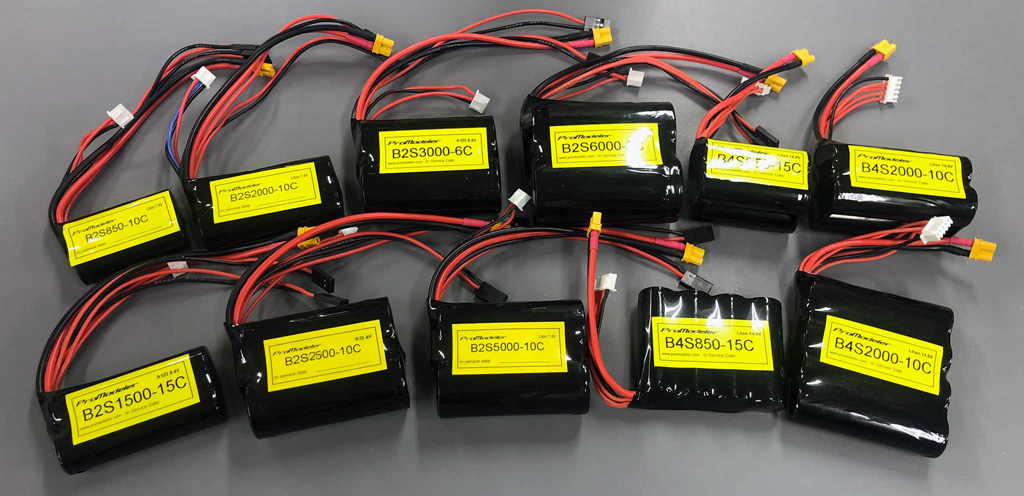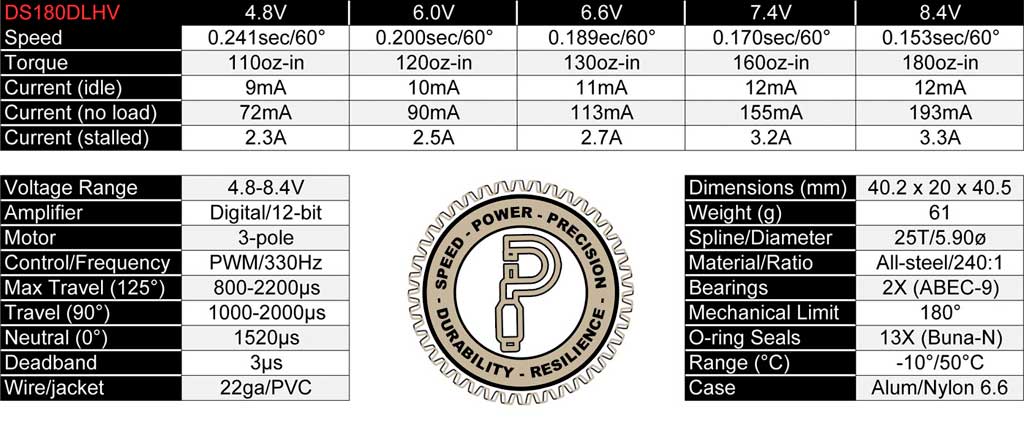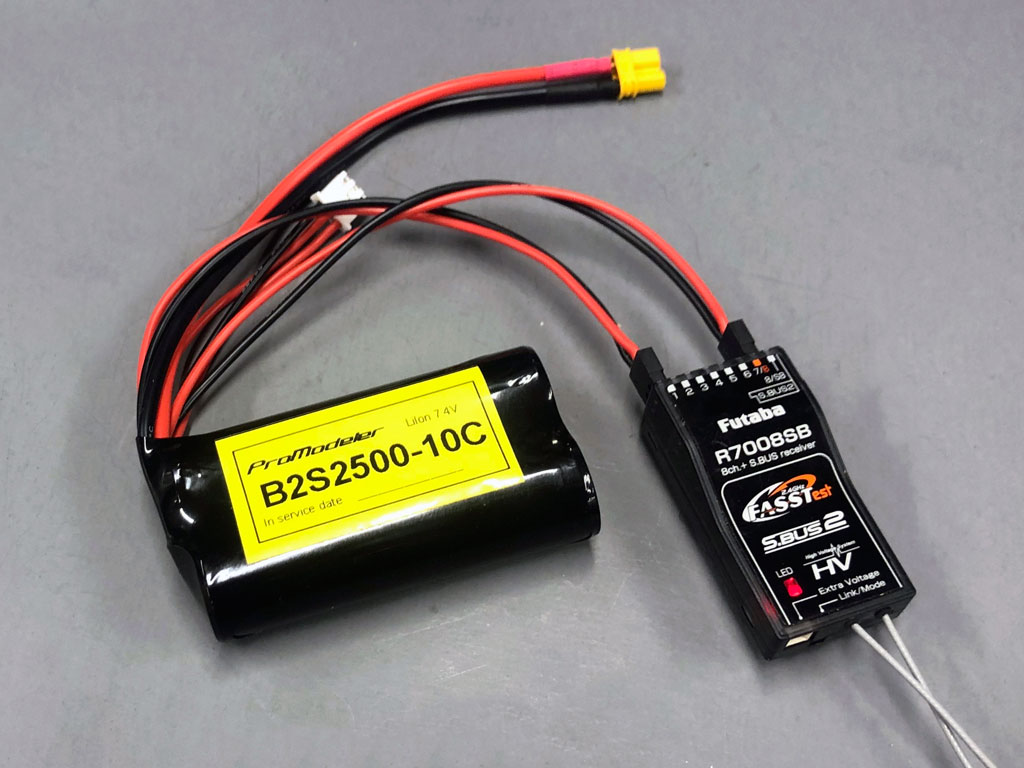As usual, an askJOHN begins with a query, either by phone or email. Often, it's not the first time I've been asked the very same question, or something similar. So because I tend to keep notes (and can always try digging through emails), I can usually whip out a response pretty quickly. However, eventually it gets to the point I'm getting enough of these it's just smarter to put together an article and post it on the site.
This was the case recently when a long time customer (and genuinely expert modeler) made a simple mistake while charging of using the wrong program for the chemistry in question. And while the topic at hand specifically regards mistakenly charging a LiFePO4 as a LiPo, it could just as easily have been a LiIon charged as a LiPo, or a NiMH as a NiCd, instead.
Unfortunately, because the final voltages aren't the same, the incorrect charge process may damage a cell, and hence the entire pack. Let's see if anything can be salvaged.

- A variety of similar looking packs, each different and requiring careful charger setup

So my customer wrote asking if the battery was toast *or* if there was something to be done to save it. And please, don't for a moment imagine this would never happen to you. Why not? Simple, it's because the fact of the matter is; this happens more often than you'd believe. And worse, some are too ashamed to admit it, and just order another pack, but remember, there are no stupid questions!
Unfortunately, packs look somewhat similar, and yes, it goes without saying you should always double-check what we're doing by reviewing the label instead of assuming, but the facts are, it has happened to me! So I developed a procedure to help avoid doing it again, and it's working.
These days I've developed the habit of pointing at the battery-label, and saying out loud;
- 'I'm setting the charger for a 2S LiFePO4 pack of 3000mAh capacity,"
Yes, to a fly on the wall it may sound silly for me to say this out loud alone in the workshop, but nevertheless, I do it religiously. And it seems to help.
Is it my original idea? Nope. In fact, I first learned the technique of point-and-say by reading an article how Japanese train conductors, in an attempt to reduce accidents, are taught to point at railway signs as they pass and say them out loud. So just like me alone in the workshop, they're alone driving the train engaged in point-and-say. Proof it works is point-and-say has reduced the number of train-accidents.
Figuring if it's a good practice for them, it's good enough for me, too, I adopted the practice and have in fact, once caught myself about to make a mistake when setting up to charge. That incident was positive reinforcement that the point-and-say technique works, and it may work for you. My advice is, give it a try.
So here's my customer's actual email, let's get to the purpose of this missive.

Q. I mistakenly charged the LiFePO4 B2S3000-10C battery I bought back in August as a LiPo.
I hadn't used the battery since I bought it and assumed it was a LiPo like the others I bought. Anyway,
when I realized my mistake, I put the battery in a storage state. When doing so, the battery meter
showed that one of the cells discharged to a lower voltage than the other. I then recharged it
as a Lilon and in the process both cells shot up to nearly full in an abnormally short time. After
disconnecting from the charger both cells dropped asymmetrically. Is there anything you think I can do
(safely) to recover the battery. I'm thinking not, but I thought I should ask.
A. Yes, you may be able to save it. I'd try cycling it a few times from storage mode to fully charged and back to storage using the proper program (LiFe in most chargers). But honestly, maybe think twice about using that pack for the receiver and servos in your model even if you do get the pack responding normally after a few cycles. Just saying.
To the fact yours are actually LiFePO4 cells instead of LiFe, while some chargers will have a specific LiFePO4, LFP, or A123 cycle (all three are common names for the same thing), most only have a LiFe setting. That's OK because while LiFe and LiFePO4 are NOT the same thing, they nevertheless seem to charge the same (or apparently close enough). Specifically to the chargers we offer on the site, when I wrote asking this very question of the supplier, what they said was . . . 'Use the LiFe setting'.
Let's briefly delve into the various cell chemistries making up the batteries we use in the sport.

Cell chemistries - NiCd vs NiMH and the four varieties of Lithium
NiCd vs NiMH
In the sport we use six common chemistries, two based on nickle and the rest based on lithium. The nickle based ones are nickle-cadmium and nickle metal-hydride, abbreviated NiCd and Ni-MH, respectively. While the final voltage of both is 1.2V/cell, chargers offer a specific charge-setting for NiCd and a totally different charge-setting for NiMh because they're actually quite different in charge-profile. The NiCd end voltage is 0.9V/cell whilst for NiMh it's 1.0V/cell. Minor difference? Yes, but a difference, nevertheless.
Worse, charging NiMh with a NiCd setting will overcharge it and the end result is a cell with reduced capacity due to the damage. Going the other way around doesn't seem to result in damage because the NiCd cell is so robust a NiMh profile won't overcharge it so no harm, no foul.
And while chargers often have a program to handle both chemistries, differences in trickle charge current as they near full means NiMH packs have a need for more sensitive full-charge detection. This makes a NiCd charge profile totally unsuitable for NiMH batteries because it will overheat the pack and damage the cells permanently.
Lithium chemistries - there are 4 in common use
The lithium chemistries are similar but different, also. In order of increasing end-voltage they're LiFe (lithium iron), LiFePO4 (lithium iron phosphate), LiIon (lithium ion), and lithium polymer (LiPo). And these are their nominal voltages;
- LiFe - 6.4V
- LiFePO4 - 6.6V
- LiIon - 7.2V
- LiPo - 7.4V
Note; nominal having the same meaning as in the dictionary, e.g. existing in name only because in point of fact, coming off charge *all* six of the battery chemistries come off hot from the charger. By this, meaning at a higher voltage than nominal.
That said, charging a LiPo with a LiFe profile won't hurt it because it just won't be fully charged. The other way around is bad juju because the charger won't stop at the proper level and the cell will begin to overheat. No bueno!
With regard to coming off hot, a LiIon may come off at 8.1V whilst a LiPo may be charged to 8.35V but in use they are considered fully discharge at a different value. So the recommendation is; when they're discharged to the nominal voltage value, we effectively say they're done and the pack needs recharging.
Anyway, LiFe packs are built in plastic bags like are used for LiPo packs. We don't sell them because of an experience with them going bad on the shelf. So we withdrew from that market altogether to avoid the risk (remember, we don't make batteries, we have them assembled to our specs, only). LiFe charged as LiIon or LiPo? Almost to a certainty toast. I'd toss it, no question.
The LiFePO4 is a similar chemistry to LiFe but they are very, very rugged and will withstand a lot of abuse. This is the specific pack in question and he charged it using a LiIon setting. That's too high of a voltage before cutoff so the cells may have overheated. Dunno. In all probability, he damaged the pack. However, these packs can take a lot of abuse, and there's a chance the pack is actually OK.
Only way to maybe know is to try charging it with the proper program a few times and see how it reacts. Charge it to the proper voltage, cycle to the proper discharge voltage (do this several times if it does), then check capacity. What if it seems to work? Then maybe you can take a chance. Me? I wouldn't.
What would I do? I might try using it for an ignition, or for a model boat or car (I do all kinds of models). But taking a chance with a model airplane? Nope, I'm too chicken. Put another way, it's just not worth the risk, and not just regarding the loss of a model but risk of crashing and hurting someone. That's definitely a risk I wouldn't want to run and my best advice is, you shouldn't either!
LiIon charged as LiPo might be OK, also. Close to the same voltage and it might be hurt, it might not, depends. LiIon cells are rugged. But same advice, charge and discharge it a few times and see if it reacts normally. Obviously, if it doesn't, you just toss it (metaphorically as you should actually recycle all battery packs at a battery center). But if it charges to full capacity, holds a charge, discharges to storage mode, and delivers rated capacity, e.g. acts totally normal, then it may be a risk you want to take. Again, I wouldn't.
LiPo charged as LiIon, this won't be hurt as it's a lower final charge point than LiIon.

On pushing things and nominal voltage
In the sport, modelers push things. Faster, longer, higher, slower, lower - whatever. And in the case of receiver battery packs, getting the most number of flights between charges seems to be a thing with some. Not me. My goal is safety first and I never try to get an extra flight out of a pack. Not when I can just field charge it, instead! We offer two DC chargers suitable for this job. Anyway, those who like doing this run the risk of a crash as the pack is discharged to lower than nominal levels.
I don't do this for probably the same reason I'm deemed a very conservative fellow by others. Yes, chicken is not a label I would shy away from because I have an active imagination and consider in advance what would happen if someone got hurt just because I was acting the idiot and trying to squeeze an extra flight out of a pack before recharging. But we're all different and in the parlance of the day, I'll do me, and you do you!
But if we're being honest, it strikes me as positively retarded to do this, but we're not supposed to say retarded anymore so let's just say it seems like a particularly dumb thing to be doing, and leave it at that. Major point being, worst case, *I* stop using a control electronics pack and recharge once the pack hits nominal voltage. And it's what I advise you do, also.
After all, what purpose does it serve to try and get one more flight before recharging? Especially in light of the fact we *know* from the servo-specs that servo-performance follows pack voltage lower. So lower voltage, less torque and slower speeds. So you're taking a risk *and* getting reduced servo performance, then . . . like duh!
Eyeball this servo chart (all of our servos have one similar) and observe how the lower the voltage, the lower the performance. Holds true for all servos, all brands!

- Different voltage, different performance - true for all servos regardless of brand

Occasionally I'm asked at what point I recharge, specifically, how many flights? Well, I don't know because it's like asking how high is high. Especially since all models are different and all modelers flight profiles are, also!
So how long *can* I use a pack between recharges?
Glad you ask because as it happens, I've written on the subject. Surprised? Don't be because I've been answering questions like these for many years. You're not the first to wonder and the reason I know is I figured out a method to determine it using a timer, a watch, and charger that displays mA returned to a pack being charged. Review this article and see if it helps;
How to determine flight time for a 2S850 LiIon?
Best part is, the answer doesn't require me to spend for telemetry (or have another distraction whilst flying, to find out). That, and it works for propulsion packs, too!

Recapping
Do you have to throw away a pack inadvertently charged with the wrong charge-setting? Maybe not according to many. When I asked my vendor this question, even they said maybe try cycling it with the correct charger setting and see what happens. If it never comes back to normal, then nothing ventured, nothing gain and toss it at whilst considering the cost being similar to tuition for a college course. The price to be paid for learning to be more careful in future.
But if it does begin acting normal (with regard to the proper state of charge), then the question is . . . do you trust your model to it? Me? Honestly? I'd be too chicken and would toss it and advise you to do the same. That's our official position.
That said, this is your decision, not mine. My advice is just that, which is using it for the receiver, is too risky, and while I'd toss it, if you can't bear to throw it away when it's charging up like it should and working, then maybe you could use it for powering an ignition module, or for a model boat or car, instead. After all, these are applications where the risks are lower. Just a thought, eh? But it depends on your risk tolerance. Remember, I would toss it without a second thought *but* my tolerance for risk is low compared to others.
Point-and-say is a technique proven to reduce train accidents and I adopted it for use with charging to help me not set the charger incorrectly. Try it!

Note; just because I own the inventory doesn't mean I don't have the same considerations you do when anguishing over tossing a $50 pack. Reason is I have to sign a chit when I grab something out of inventory. Yup, I get billed and pay just like you.
So believe me when I say, I totally understand why you want to salvage it because it wounds my soul to throw away a battery pack that seems to be charging up just fine but in fact, I do bite the bullet and buy another pack!
Remember, the risk isn't just to the model because a failure at the wrong time possibly could lead to someone getting hurt. Long odds? Shitty luck? Yes, but it can happen. Heads up!

- ProModeler packs are built with multiple leads permitting dual switches for safety!

Well, this may be a record for fewest words in an askJOHN but that's all I've got. I may add to this article if my opinion changes, or I learn something to change my opinion (we're always learning) and please remember, I merely offer these thoughts as my opinion (and opinions are like belly buttons in that we all have one) but you, and you alone, decide what course of action to follow because you're the captain of your destiny, capsici?
Further questions, advice, thoughts? Email them to info@promodeler.com or call 407-302-3361